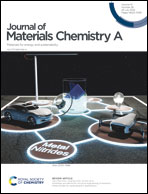MOF-derived CoFe alloy nanoparticles encapsulated within N,O Co-doped multilayer graphitized shells as an efficient bifunctional catalyst for zinc--air batteries†
Abstract
Metal–organic frameworks (MOFs) and their derivatives are promising electrocatalysts for zinc–air batteries due to their advantages of reconfigurable metal nodes and abundant coordinatively unsaturated active sites. However, current MOF-derived composites are mostly microporous and have low graphitization, which are deemed unfavourable for ion and electron transport. Herein, we report CoFe alloy nanoparticles encapsulated in N,O co-doped multilayer graphitized shells as effective bifunctional catalysts as well as the simple and practical preparation of cobalt/iron MOFs and their subsequent carbonization. The resulting heteroatom-doped carbon highly graphitized bimetallic catalysts were examined by electrochemical tests and deliver a minimum ΔE (ΔE = Ej10 − E1/2) of 0.678 V and exhibits high durability after long-term testing. The homemade zinc–air battery has a high power density (>200 mW cm−2) with a high specific capacity (829.5 mA h g−1). In addition, the zinc–air battery exhibits high stability during battery cycling processes. Therefore, this work provides a promising pathway for advanced metal–air cathode materials.



 Please wait while we load your content...
Please wait while we load your content...